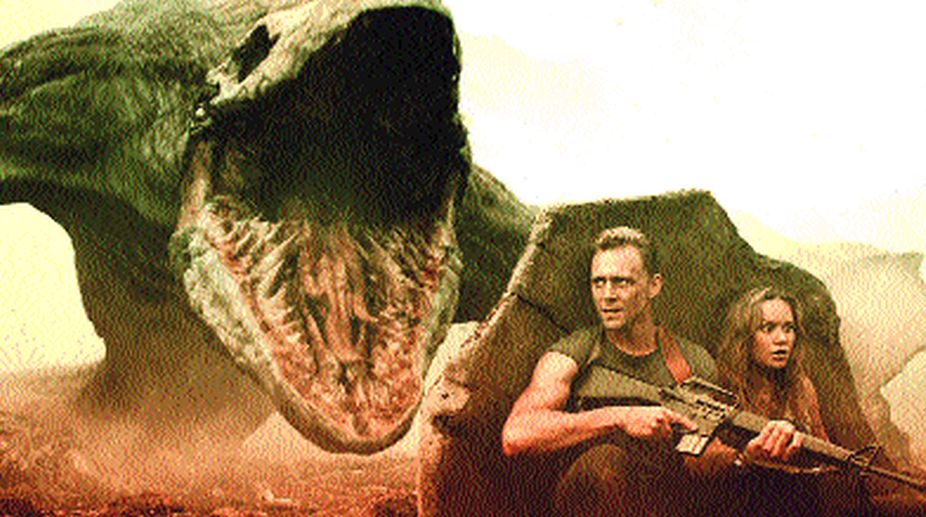Work that conveys emotions and ideas
If you are creative and imaginative, a degree in visual arts could be just what you require to express yourself.

In a scene near the start of Kong: Skull Island, (top) a band of adventurers buzzing around in military helicopters comes face-to-face with the monster that gives the film its title. A spectacular vertigo-inducing battle ensues between Kong and the copters. Much of that scene was done at Industrial Light and Magic Singapore. Visual effects supervisor, 41-year-old Jeff Capogreco, says that the scene “introduces us to Kong and he isn’t very happy. People are invading his home”.
It is a complex sequence about three minutes long, composed of 150 “shots”, the unbroken scene between two cuts. Real actors inside dummy aircraft whirl around the digitally-created Kong, with the fight taking place against jungle scenery and sky, which might also be painted in by computer.
Advertisement
“Singapore did the helicopters being smashed and crushed. Kong is roaring and jumping,” says Capogreco, who has worked there since 2014. ILM’s other studios — in London, Vancouver and their head office in San Francisco — also worked on the film.
Advertisement
The giant ape is 30m-tall — two times taller than the one in 2005’s King Kong, directed by Peter Jackson. This new Kong is the largest in Hollywood history, says Capogreco. Director Jordan Vogt-Roberts said he needed Kong to be enormous to create a sense of awe.
Jackson’s film featured a smaller, acrobatic Kong able to leap from spot to spot. It also had to fit inside a New York theatre in the final act. Vogt-Roberts’ Kong, however, does not have to fit in a theatre nor tenderly cradle a woman in his hand — his less nimble Kong needed to be massive enough to crush a helicopter in one hand.
Capogreco says advancements in software now provide a much greater level of creature realism, compared with the 2005 ape. The quality difference can be seen in one detail — hair. The more hair a furry digital creature has, the more realistic it looks. “We can render five to 10 times more hair now than we did 10 years ago,” says Capogreco, who is Canadian.
Rendering, the process of turning computer code into an image, requires computational horsepower. With each hair on Kong’s body having its own colour and length, and each patch acted on by sunlight and wind in different ways, the resources involved are huge, he says.
Like Jackson’s Kong, the Kong of the new movie is based on capturing the motion of an actor, then mapping the motion onto a digital version. Actor and movement coach Terry Notary, who has worked on films such as Warcraft (2016), Dawn of the Planet of the Apes (2014) and The Hobbit trilogy (2012-2014), provided the facial expressions and body movements for the new Kong. 41-year-old Ashwin Ram had no human actor to base his creatures on. The Indian national, a lead modeller at ILM Singapore, helped create the Skullcrushers — the fast-moving, car-sized two-legged animals attacking the humans in Kong. “They are based on fantasy, but they have to behave in a realistic way,” he says. This means they have to move in ways that make sense to viewers because people have preconceptions about how animals move, he adds. He based the Skullcrushers on a variety of reptiles — Komodo dragons, monitor lizards and snakes. “The challenge was to create a creature that could be both a snake and lizard,” he says.
Chelsea Khoo, 37, creature technical director at ILM Singapore, faced a similar issue of making the fantastical look realistic, except her job is on a different scale. The Singaporean artist specialises in making simulations of fur, cloth and flesh look real. Every creature has one of these coverings. Kong, of course, is all fur.
“Different areas have different fur. The hair under the arms and on the legs is longer, while the hair on the top of the head is short. The direction of the hair growth is different. When Kong moves, the wind acts on them differently,” she says. She studied videos of gorillas on television and YouTube to make sure she got it right, says Khoo, who had also worked on the recent fantasy epic The Great Wall (2016).
Kong’s fur presents one set of issues, but hairless creatures such as The Great Wall’s tao tie monsters are just as tricky because muscles moving under skin have to follow natural- looking patterns too, she says. That film’s other challenge was cloth — in particular, the flowing capes of warriors.
The actors wore real capes, but director Zhang Yimou asked ILM Singapore to digitally enhance the billowing of the soft, silken fabric worn by soldiers in battle. How does one learn the behaviour of cloth under different conditions? One conducts experiments. “We took videos of ourselves wearing capes. We jumped, we fought; we rolled on the floor to get a good idea of how the fabric would look.”
the straits times/ann
Advertisement